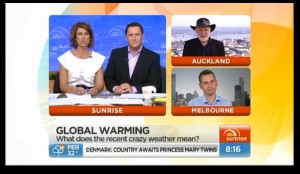 Sydney Morning Herald, January 1, 2011
Sydney Morning Herald, January 1, 2011
Climate scientists want us to understand the world is burning, writes Adam Morton.
THE climate scientist Neville Nichols has long believed his role was research, not advocacy. But when he woke on the morning following the Black Saturday bushfires in Victoria, turned on his TV and caught his breath after witnessing the shocking aerial footage of what was once Marysville, he instinctively blamed himself.
”My initial thought was ‘Is this my fault? Has this happened because I haven’t been out there saying that this stuff is going to have catastrophic consequences for us?”’
Advertisement: Story continues below
”It is the first time I have ever been shaken from my belief that I shouldn’t be an advocate on climate change.”
Nicholls – an Australian Research Council professorial fellow at Monash University and an author and reviewer with the UN’s Intergovernmental Panel on Climate Change – resolved to take more responsibility to be a public voice; not to lobby for a particular political response, but to explain and defend the science that is his life’s work.
He was not alone. Increasingly, as the first decade of the century unfurled, Australia’s most decorated scientists in climate fields were concerned that published evidence in their areas of expertise was being misused or ignored. Believing they faced a calculated misinformation campaign driven by fossil fuel interests and an intransigent political system, they formed Climate Scientists Australia as a means to improve the quality of public information and decision-making.
The public debate over climate change has yielded its share of controversies, confected and otherwise, but in the eyes of leading scientists the royal commission into the bushfire’s response – which barely mentioned climate change – is emblematic of the biggest of the past 10 years: the failure to convince policymakers and shapers to take the warnings of the world’s most reputable scientific agencies seriously enough to respond effectively.
The global public’s awareness of climate change grew significantly over the decade, but by this year, according to some polls, its acceptance of the science had diminished.
The decline was particularly marked in Britain and the United States. Britain was home to the affair in which senior scientists were accused of manipulating data after ambiguous emails were leaked from the University of East Anglia. The scientists were exonerated of the most serious claims of dishonesty by a series of inquiries, but the damage was done – the findings clearing their names received only a fraction of the media coverage of the initial allegations.
A separate investigation by the InterAcademy Council recommended changes to the IPCC, including greater transparency, but found its work synthesising published climate science was mostly successful.
In the US there was a concerted attack from the resurgent Republican Party and influential parts of the media claiming climate science was a hoax and conspiracy. A University of Maryland study published last month found Fox News viewers were 30 percentage points more likely to incorrectly believe that most scientists do not agree that climate change is occurring, or that views are split.
The public mood was not helped by the debacle of the United Nations Framework Convention on Climate Change meeting in Copenhagen in December 2009, which left people with the not unreasonable perception that the world’s leaders had no idea how to tackle the problem. The recent follow-up meeting in Cancun managed to glue the pieces of the broken talks back together, but left the most challenging issues in forging a new treaty to build on the Kyoto Protocol – which covers little more than a quarter of global emissions – to a later date.
Meanwhile, the claims made on climate change’s behalf continued to mount. Delegates in Cancun were handed a report by the aid agency Oxfam that quoted the insurance agency Munich Re. It linked 21,000 deaths in the first nine months of 2010 to climate change. It was twice the number of casualties caused by extreme weather events in all of 2009.
The mid-year floods that soaked a fifth of Pakistan alone killed about 2000 people and affected the lives of 20 million. The same weather system caused extraordinary summer heat in near-Arctic Russia that wiped out crops, caused rampant wildfires and doubled the usual summer death rate for Moscow.
These events rang alarm bells for those familiar with the IPCC’s projection, based on more than 20 climate models that to date have proved remarkably accurate, that a significant temperature rise above pre-industrial levels will increase the likelihood of floods in southern Asia and the risk of heatwaves and wildfires in Europe.
Munich Re reported that its database of natural catastrophes showed that the number of extreme weather events such as windstorms and floods had tripled since 1980 ”and the trend is expected to persist”.
It should be noted that not everyone working in the area is comfortable with linking the present shift in extreme events with greenhouse gases. According to one view, there is little to no change in the proportions of people affected once population growth is factored in.
What does not remain a contested area in the scientific literature is that the planet is becoming hotter. Analysing the data from the world’s three temperature data sets, the World Meteorological Organisation reported in November that the past decade was the warmest since instrumental measurement began in 1850, and 2010 was on track to be the hottest – regardless of the extraordinary snow dumps clogging European and US cities over Christmas.
(In fact, there is significant evidence to suggest that global warming is responsible for the extreme northern winters of the past two years. An increase in air pressure in the Arctic atmosphere caused by warmer heat coming off a relatively ice-free ocean is pushing cold air south.)
Eighteen countries broke their records for the hottest day ever this year. Only one year in the 20th century, 1998, was warmer than any so far in the 21st.
The noughties was the decade of the killer heatwave. Western Europe was hit in August 2003, when extreme heat was estimated to have contributed to the deaths of 46,000. There were widespread crop failures and forest fires, particularly in southern Europe. About a tenth of Portugal’s forests burned.
In Australia, Victoria had never had three consecutive days above 42 degrees until January 2009, when there were three above 43 degrees. The January heatwave is estimated to have killed 500 people in Victoria, South Australia and Tasmania.
Perhaps the biggest change came in Russia this past northern summer, when at least five days in Moscow topped 100 degrees Fahrenheit (38C) – a barrier that had never been crossed. An estimated 15,000 people died and the country’s massive grain harvest was devastated by wildfire.
The Russian state weather service chief, Alexander Frolov, said it was the country’s worst heatwave in a millennium. ”Nothing like it can be seen in the archives.”
Meanwhile, greenhouse gas emissions have continued to rise. Last month the Mauna Loa Observatory in Hawaii showed that atmospheric carbon dioxide had reached 390 parts per million – a 40 per cent increase on pre-industrial levels.
All of this is in line with the IPCC’s most recent assessment report, published in 2007, which found that there was at least 90 per cent certainty that most of the increase in the globe’s temperature since mid-last century was due to the rise in industrial greenhouse gases.
There is, of course, still significant uncertainty about the future effect of climate change. But the fundamentals predicted by climate models – marked declines in Arctic sea ice in summer, rising sea levels due to thermal expansion and glacier melt and increases in temperature – are being matched by observations.
That is the science. The response, the politics and economics, remains a thornier question still.
The preferred model under the 1997 Kyoto Protocol is carbon trading, under which emissions are capped and pollution permits exchanged so that the cheapest way to meet the target can be found. This method has been adopted in haphazard fashion across Europe, New Zealand and a band of US states, and several more countries including Australia and China are looking at signing up.
There is near universal agreement among economists that a carbon price is the most efficient way to reduce emissions, but carbon trading faces criticism that, while nice in theory, it is ineffective in the real world when it includes poorly policed offset schemes. The US Congress has rejected a national trading scheme; Japan and South Korea have postponed the decision on theirs.
What are the hopes of a global solution to this diabolical problem? A recent prognosis by the Paris International Energy Agency found the national targets submitted under the loose Copenhagen Accord of 2009 would put the world on a path of 3.5 degrees warming by the end of the century. Even if you assume that countries introduce policies to back their international promises – Australia and the US, to name just two, at present have no way of meeting their targets – few scientists or policymakers expect the temperature rise to be kept within two degrees, the goal agreed under the UN process.
In Australia this year there will be a concerted effort from Labor, the Greens and parts of the business world to introduce a carbon price – most likely a tax that could evolve into carbon trading. Attention is then likely to turn to the challenge that has only just begun to find its way into the public debate, but will increasingly become apparent over the next decade: adapting to unavoidable change.






 By
By 